Features of the solid wood board
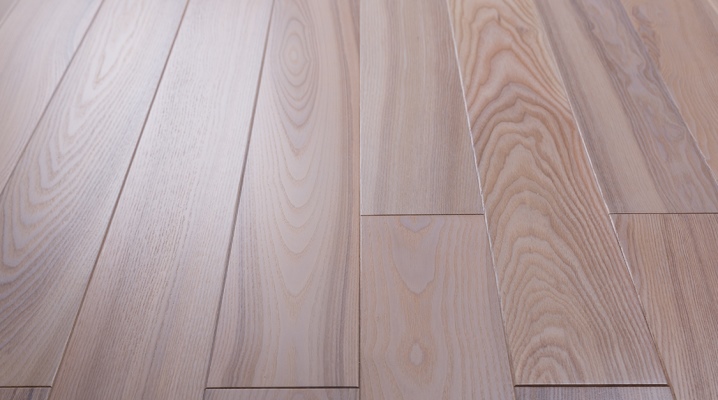
Solid wood board - what is it, why is it better than block parquet: these questions regularly arise among people who want to diversify the interior design in their house or apartment. This material for finishing the floor periodically requires scraping, but fully justifies the investment due to its aesthetics, practicality and durability. To find out more about the advantages of a solid board made of ash, bamboo, American walnut and other species, a detailed overview of the most popular options will help.
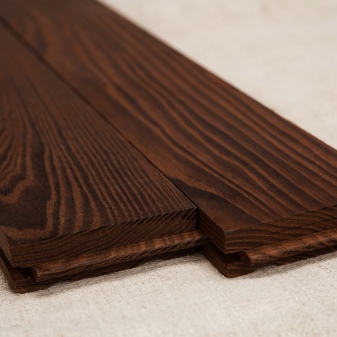

What it is?
Luxurious, durable, aesthetically pleasing - solid flooring can be considered a flooring with virtually no disadvantages. It is made of solid wood, has tongue-and-groove joints to facilitate installation, as well as compensation cuts on the back to prevent deformation. In the manufacture of the material, adhesives are not used. Solid wood board is a one-piece product, varnished or oiled in the factory.



In addition to decorating floors, it can also be mounted on a wall, podium, niche and other architectural elements in the interior.
On sale, a board made of solid natural wood is presented in several versions.
-
Radial. It is a material with no visible defects, perfectly matched and processed. Such panels are cut radially, have the same fiber direction, uniform color over the entire area. A solid board of this class is the most durable and wear-resistant.
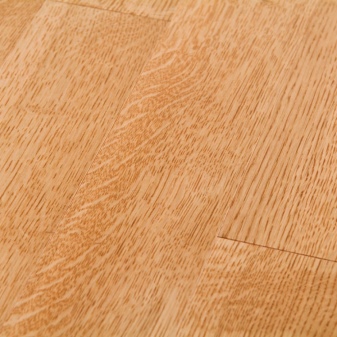

- Select. This class of board is distinguished by its rich texture and variety of patterns. Raw materials are carefully selected in production, and high quality requirements are set for them. This type of board is more sensitive to moisture than others, it needs to maintain a stable indoor climate. Its advantages include a variety of colors and shades, which allows you to create interesting design solutions in the interior.

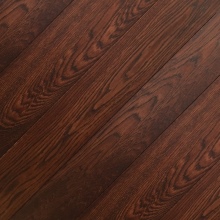

- Natures. This class of solid board allows the presence of such small defects as knots, sapwood. The material is distinguished by a single color, original texture, and affordable cost.


- Rustic. The most unusual version of a massive board, heterogeneous in structure. Various flaws - color changes, knots, small cracks - are considered its main advantage, giving the wood a "live" look. This material is popular in country style interiors, but is more difficult to restore than others.


Each type of solid wood board has its own obvious advantages, for which it is appreciated by interior designers. The main characteristics of the material - dimensions, thickness - remain standard for all options.
What are they made of?
A solid board consists of solid wood that has been processed on special machine equipment. It is available without coating or with pre-applied varnish, oil, completely ready for installation. The individual characteristics of a particular material largely depend on what kind of wood was used in the production. Among the most popular, there are several options.
-
Ash. An elegant, stylish, solid board made of this wood species is distinguished by a wide range of light shades.It is resistant to deformation, strong, durable. Ash wood is quite elastic, does not dry out, but is capable of intensively accumulating moisture, pliable for rotting, insect damage.


-
Bamboo. A very beautiful and lightweight material, from which the board is obtained with a characteristic golden hue. An array is made by connecting several strips. The exotic coating is durable, resistant to swelling and mechanical damage.



-
Nut. The beautiful grain pattern of this tree is complemented by the high hardness of the material derived from it. The American walnut, found in the most respectable houses, is especially highly valued by designers. The light beige shade of its fibers appears much brighter when varnishing, applying oil.



-
Teak. A rare and valuable tree, its Burmese subspecies is valued above all. Differs in original pattern, pleasant texture. Such a massive board is expensive, but it looks very respectable.



- Wenge. Wenge wood, which is quite capricious in processing, can dry out if not properly dried. Nevertheless, a massive board made of it is very decorative, has strength, and has a long service life.



Not too high value has a solid board made of birch, other available wood species. It is more prone to cracking, abrasion. It can change its geometry under the influence of high humidity, as well as when changing temperature conditions.
Other wood species
The options for boards made of solid natural wood of other valuable species are no less appreciated. Typically, a base with a dense and solid structure is used here. The cost of some products turns out to be very high, but such floors or wall panels serve as panels for centuries. Several types of wood are considered to have such advantages.
-
Rosewood. Very beautiful floors are obtained from this material. The dark color of rosewood, combined with an interesting grain structure, gives the coating a special decorative effect. The lamellas are strong, durable, not too sensitive to moisture.



- Oak. An expensive version of a solid board made of its wood has a rich color, dense fiber structure. Hydrocyanic acid contained in the material provides protection against rotting, mold formation. Such a floor covering is very resistant to moisture, shock loads, and abrasion.



- Maple. Its wood is highly valued for its hardness and strength, it has an attractive light shade. Solid maple board is not susceptible to cracking, but is sensitive to moisture levels, swells on contact with water.


- Larch. Its wood is famous for its hardness, resistance to decay. Larch massif is able to maintain its properties for centuries without loss of fiber density.



It is the materials made from these types of wood that are especially highly valued. Depending on the hardness of the raw materials, the solid wood board can be used in rooms with high traffic or where mechanical stress on it will be minimal.
In any case, this material fully justifies the funds invested in it, and surpasses any artificial counterparts in its durability.
Advantages and disadvantages
Solid planks have many advantages that other coatings do not have. There are a number of obvious advantages of this material.
-
Environmental friendliness. The solid board does not contain chemically aggressive and hazardous substances. It is hypoallergenic, suitable for use in living quarters, children's rooms, bedrooms.
-
Long service life. The material is produced using a special technology that allows you to preserve all the best properties of natural wood. The average service life of a solid board is 30-50 years, but many of its samples in the castles of Europe retain their properties for 200-300 years.
-
Ease of recovery. The considerable thickness of the wood makes it possible to provide an opportunity for scraping the floor in case of damage to its surface.
-
Pleasant tactile sensations. Natural wood, unlike its artificial counterparts, is a warm material. It is comfortable to walk on it at any time of the year.
-
Excellent insulating properties. Surfaces finished with solid wood boards reduce heat loss and drown out loud sounds.
-
Ease of installation. The tongue-and-groove laying ensures a tight fit of the elements without effort. The floor does not dry out during use.
-
Ease of maintenance. The surface of the material can be damp-cleaned, polished, varnished or oiled as needed.
-
Aesthetic appeal. Massive board is one of the most respectable options for decorative coatings. With its help, luxurious interior solutions are created in both classic and modern styles.




The disadvantages include the flammability of the material, its instability to strong temperature changes. Such a coating requires the formation of a special substrate, while it does not allow the "warm floor" system to be mounted below. The high cost of natural material can also scare off those looking for options for an economy class renovation.
Comparison with other coatings
Unlike block parquet, a solid board has larger dimensions - it is much longer and wider. Such material always has a decorative and protective coating based on wax, varnish, oil. The massive one differs from the parquet board in a homogeneous, solid structure that does not have layers. This is precisely wood, without inclusions of glue and other materials.


An engineering or super-massive board is better adapted for use under loads. It is not used as a covering. This is a full-fledged engineering structure with a specific purpose. Compared to a floorboard, the massive version wins when it comes to using it as a finish. It looks more attractive, already has a decorative finish, and requires preliminary leveling of the surface.


Dimensions (edit)
Solid wood planks can vary considerably in size. A wide range of dimensions allows you to create an original pattern of the coating, to vary the methods and schemes of its laying. The standard parameters look like this:
-
thickness - the minimum indicator is 15 mm, the most common sizes are from 18 to 22 mm;
-
width - the narrowest board has indicators of 100 mm, the widest one reaches 200 mm;
-
length - it varies from 500 to 3000 mm.
Dimensional parameters may vary depending on the preference of the manufacturer. For example, the width may differ from the standard by 15 mm.

How to cover?
The application of decorative and protective agents on the solid wood board is made by the manufacturer. But when repairing, restoring, the coating has to be renewed. In this case, the master himself can choose the appropriate type of coverage.
-
Varnish. It must be UV cured. This will speed up drying. The varnish is applied in a very thin layer, it is worth choosing transparent, non-tinted varieties. Such a coating is characterized by low maintainability - if it is damaged, the entire layer will have to be renewed.
-
Butter. This type of impregnation preserves the natural structure and roughness of the wood. Oil coatings ensure that the surface of the material is not penetrated too deeply. They need to be renewed every 3-12 months. At the same time, the surface lends itself well to local repair.
-
Oil-wax. The most popular type of decorative coating. It is a combination of paraffins and oils, similar to the classic mastic. The formed film protects the massive board well from moisture and dirt, periodically requires renewal, and lends itself to local repair.

In addition, the material can be additionally subjected to decorative processing - sanded, brushed, toned. This will give even the old floor an aesthetic look.
Mounting
The technology of laying a solid board on the floor assumes its rigid fixation. In rare cases, the flooring is performed on a screed - such a coating can be put on a concrete monolith, but it is better to provide an additional layer in the form of plywood sheets. Instructions for working with the material presuppose the creation of certain conditions.

It is necessary to adhere to the correct temperature and humidity of the air, wait until the screed completely hardens, giving up excess moisture.
Installation of a solid board can be carried out both with glue and without glue.
-
Kleeva. For these purposes, they take epoxy-polyurethane compositions. For the drying period, the planks are additionally fixed with parquet screws or studs. Do not use adhesives based on synthetic resins or water dispersion.
-
Glueless. This method is used when installing flooring and wall cladding. A massive board is not rigidly fixed to the base, it retains its mobility. In this case, additional profiling of the joint is performed or brackets are installed, placed in the cuts on the back of the lamellas. This is usually how bamboo boards are mounted.


When choosing a fastening method, it is important to take into account the possible needs of the coating for subsequent repairs, the intensity of its wear. The floating method is only good for non-stressed structures. For any type of installation, the first row must be indent from the wall at a distance of about 1 cm.
How to loop?
Updating a solid board covering may be required if it is damaged, dirty, or dry. In this case, the material requires scraping - a special treatment that allows you to easily rid the surface of the wooden finish from scratches, stains, and other defects. It is quite possible to complete it with your own hands, following a certain plan.
-
Preparation. It is necessary to stock up on a manual cycle and a special tape-type machine for working on large areas. At this stage, the room is freed from furniture. Fasteners in the covering, if any, are deepened. And you can also carry out preliminary wet cleaning.
-
Elimination of defects. Departing strips are fixed with nails or glue, the squeak is "treated" by installing wooden pins, large gaps are filled with thin chip inserts. It is impossible to use putty - stains will remain on the material.
-
Looping. The cutting tool moves along the grain, along the wood slightly moistened from the spray gun. A well-honed tool removes thin chips, a blunt tool creates dust. With machine scraper, waste is collected in a special bag. The work is carried out with sandpaper No. 16-40, in total, from 1.5 to 5 mm of the coating is removed.

A circularized solid board is sanded by hand or using a special power tool. Then dust is removed, a new decorative coating is applied.
Examples in the interior
A solid board in a living space can look quite rough, but experienced designers easily turn it into the main accent in the interior:
-
in a stylish modern kitchen-dining room, an elegant wooden floor without unnecessary sheen becomes a full-fledged detail of the environment;
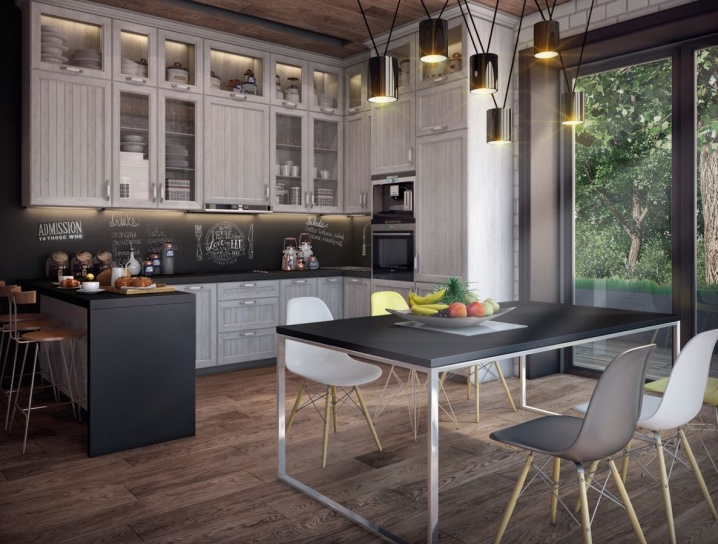
- a glossy solid board of small width in the bedroom gives the space of the room a special coziness and comfort;

- the light wood covered with oil, in combination with the eco-style interior, looks very natural, harmoniously sets off the furnishings.














The comment was sent successfully.